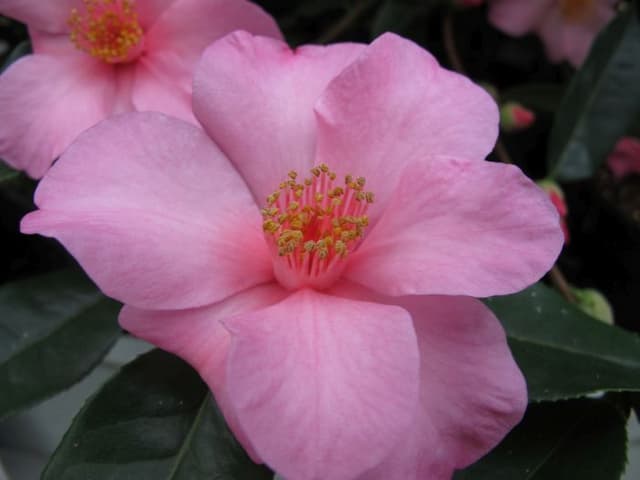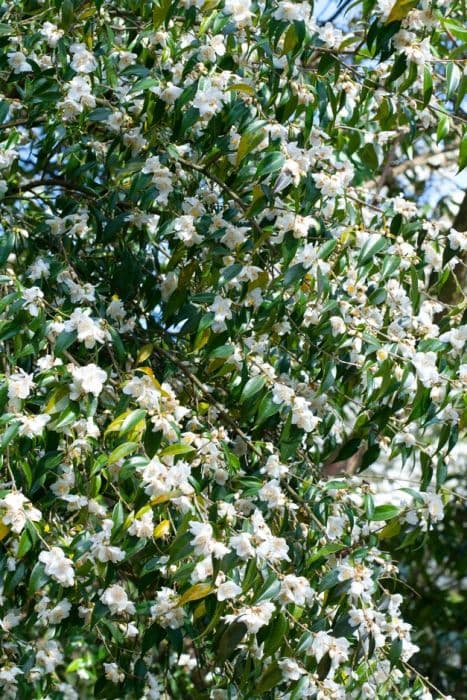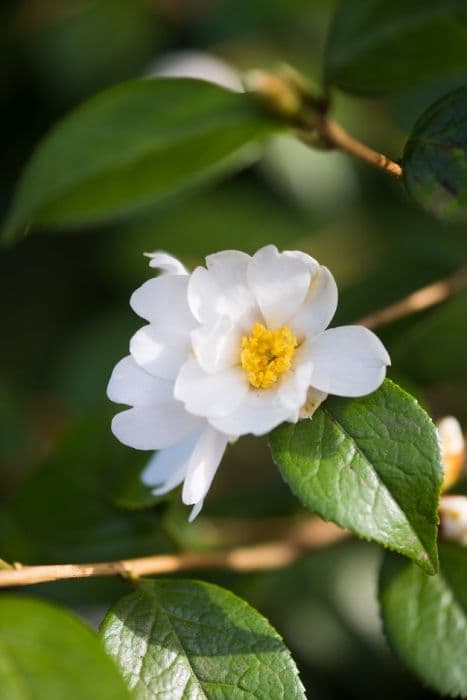Williamsii Camellia Camellia × williamsii 'Brigadoon'

ABOUT
Camellia × williamsii 'Brigadoon' is a strikingly beautiful ornamental plant with an appearance that embodies both elegance and vibrancy. This cultivar is known for its luscious green foliage that serves as a perfect backdrop for its bloom. Each leaf presents a glossy surface and a leathery texture, with an ovate shape that ends in a delicate point. The flowers are the true show-stoppers of this plant, with their large, ruffled appearance drawing the gaze of any passerby. Each flower is comprised of multiple layers of petals that interlace to create a full, rounded shape. The petals themselves are imbued with a soft, creamy pink color that can range from a pale hint to a more pronounced blush, depending on the petal and where it sits within the overall structure of the bloom. In the center of the flower, the stamens are typically a contrasting golden yellow, adding a touch of warmth to the cool pink petals. These stamens radiate out from the center, creating an appealing texture and giving a subtle yet noticeable depth to the blooms. 'Brigadoon' flowers have a tendency to make their appearance in a showy display, with the blossoms generously dotting the shrub. When in full bloom, this camellia variety can turn into a stunning spectacle of color and form, enlivening any garden or landscape where it is grown. The flowers are known for their longevity, often persisting on the plant for several weeks, and in certain conditions, the blooming period may extend, providing a long-lasting burst of color. While the description intentionally avoids specifics about the size of the plant, 'Brigadoon', like many camellias, is generally appreciated for its visual impact, which is a combination of its elegant blooms, robust greenery, and the overall lushness it brings to a garden setting.
About this plant
 Names
NamesFamily
Theaceae.
Synonyms
Williamsii Camellia, Hybrid Camellia.
Common names
Camellia × williamsii 'Brigadoon'.
 Toxicity
ToxicityTo humans
Williamsii Camellia 'Brigadoon' is generally considered non-toxic to humans. There are no well-documented cases of poisoning from this plant in humans, and it is not known to contain any substances that are harmful if ingested. However, it is always a good practice to avoid eating ornamental plants due to potential unknown risks or individual allergies.
To pets
Williamsii Camellia 'Brigadoon' is also considered non-toxic to pets. It is not listed among plants that are known to be poisonous to dogs, cats, or other domestic animals. Therefore, if a pet ingests part of a Williamsii Camellia 'Brigadoon', it is not expected to experience any significant toxic effects. However, as with humans, ingestion of ornamental plants should be discouraged to prevent potential gastrointestinal upset or other unexpected reactions.
 Characteristics
CharacteristicsLife cycle
Perennials
Foliage type
Evergreen
Color of leaves
Green
Flower color
Pink
Height
6-12 feet [1.8-3.6 meters]
Spread
6-10 feet [1.8-3 meters]
Plant type
Shrub
Hardiness zones
7-9
Native area
East Asia
Benefits
 General Benefits
General Benefits- Ornamental Appeal – Camellia × williamsii 'Brigadoon', commonly known as Williamsii camellia, has vibrant flowers and evergreen foliage that enhance the aesthetics of gardens and landscapes.
- Long Blooming Season – It typically blooms from late fall to early spring, providing color during a time when few other plants are in flower.
- Shade Tolerance – Williamsii camellia can thrive in partially shaded conditions where many other blooming plants cannot, making it ideal for woodland gardens or shaded borders.
- Drought Resistance – Once established, it can tolerate periods of drought, reducing the need for frequent watering.
- Wildlife Attraction – The flowers can attract pollinators like bees, which are essential for the health of many ecosystems.
- Low Maintenance – This plant requires minimal pruning and is relatively free from pests and diseases, making it easy to care for.
- Versatility – It can be used in various garden designs, including formal, cottage, and woodland settings, as well as for container gardening.
- Soil Adaptability – Although it prefers acidic, well-drained soil, it can adapt to various soil types if well cared for.
 Medical Properties
Medical PropertiesThis plant is not used for medical purposes.
 Air-purifying Qualities
Air-purifying QualitiesThis plant is not specifically known for air purifying qualities.
 Other Uses
Other Uses- Artistic inspiration – Camellia Brigadoon’s vibrant pink blossoms are a popular subject for botanical artists and photographers, who capture its beauty in various art forms.
- Dye source – The petals can be used to naturally dye fabrics or paper, imparting soft hues for craft projects.
- Floral arrangements – The sturdy blooms and glossy leaves of Camellia Brigadoon make it a favored choice for ornamental floral displays and wedding bouquets.
- Educational tool – Horticulture students often study this hybrid plant to learn about breeding programs and hybridization techniques in camellias.
- Culinary decoration – Although not commonly eaten, Camellia Brigadoon flowers can be used as elegant, non-toxic garnishes for food plating and cake decoration.
- Nature-inspired design – The distinct shape and color of Brigadoon blooms inspire patterns and designs in textiles, wallpapers, and other home decor items.
- Scented products – While not as potent as other fragrant species, Camellia Brigadoon can be incorporated into potpourris or scented sachets for a subtle floral aroma.
- Symbolic gift – Given their beauty and rarity, these camellias are often exchanged as a sign of esteem and adoration, marking important occasions like anniversaries or milestones.
- Photography workshops – Their stunning blooms can be the primary subject for specialized photography workshops, especially during the flowering season.
- Theme gardens – Camellia Brigadoon is used in themed gardens to exhibit variation within the Camellia genus, attracting plant enthusiasts and gardeners.
Interesting Facts
 Feng Shui
Feng ShuiThe Camellia is not used in Feng Shui practice.
 Zodiac Sign Compitability
Zodiac Sign CompitabilityThe Camellia is not used in astrology practice.
 Plant Symbolism
Plant Symbolism- Adoration and devotion: The Camellia flower, generally, symbolizes unwavering and devoted love. The intricate petals and long-lasting blooms of Camellia × williamsii 'Brigadoon' reflect the strength and endurance of deep affection.
- Perfection and excellence: As a plant that often embodies the pinnacle of breeding and beauty, Camellia × williamsii 'Brigadoon' is often associated with the pursuit of perfection and the embodiment of excellence in one's endeavors.
- Admiration: Given as a gift, this Camellia plant can express genuine admiration for someone's qualities, symbolizing the giver's respect and high regard for the recipient.
- Gratitude: Camellias can be given to convey gratitude, offering a beautiful and elegant way to say "thank you" while acknowledging someone's kindness or hospitality.
 Water
WaterWilliamsii camellias, including the 'Brigadoon' variety, prefer consistently moist but well-drained soil. They should be watered thoroughly when the top inch of soil feels dry to the touch. Generally, this will be about once a week, but it can vary depending on the climate and weather conditions. Aim to provide the plant with at least one to one and a half gallons of water each watering session during the growth season, ensuring a deep soak that encourages the roots to grow downward. During the winter months, reduce watering to avoid soggy soil, which can lead to root rot.
 Light
LightThe Williamsii camellia 'Brigadoon' thrives in partial shade, avoiding direct afternoon sunlight which can scorch its leaves. An ideal location would be under the light canopy of tall trees providing dappled sunlight or on the north or east side of a building. Protection from the hot midday sun will ensure the foliage remains vibrant and the blossoms are protected.
 Temperature
TemperatureWilliamsii camellias like 'Brigadoon' prefer moderate temperatures and are hardy in USDA zones 7 to 9. They can tolerate minimum temperatures down to around 5°F but perform best when temperatures range between 60°F and 75°F. It is crucial to protect them from cold winter winds and extreme temperature fluctuations which can stress the plant.
 Pruning
PruningWilliamsii camellias, including the 'Brigadoon' variety, should be pruned to remove dead or weak branches and to shape the plant, promoting healthy growth and airflow. The best time to prune is after flowering, generally in late winter or early spring. Pruning at this time ensures that you won't cut off next year's buds, which are set shortly after the flowers fade.
 Cleaning
CleaningAs needed
 Soil
SoilCamellia 'Brigadoon' requires well-draining, acidic soil with a pH of 5.5 to 6.5. A good mix would be equal parts of peat moss, pine bark, and perlite or sand to enhance aeration and drainage.
 Repotting
RepottingCamellia 'Brigadoon' should be repotted every 2-3 years or when it has outgrown its current container, ideally in the spring before the growing season begins.
 Humidity & Misting
Humidity & MistingCamellia 'Brigadoon' thrives in moderate to high humidity levels, ideally between 40-60%, which supports healthy growth and bloom development.
 Suitable locations
Suitable locationsIndoor
Keep in bright, indirect light and maintain high humidity.
Outdoor
Plant in partial shade, shelter from strong winds, mulch well.
Hardiness zone
7-9 USDA
 Life cycle
Life cycleCamellia × williamsii 'Brigadoon', commonly known as Williamsii Camellia, begins its life as a seed which germinates in favorable conditions of moisture and temperature, establishing a small root system and seedling shoot. The seedling stage involves the development of primary leaves and the establishment of a more robust root system to support future growth. As it enters the vegetative stage, it develops a woody stem and fuller foliage, gradually maturing into a shrub with a size and shape depending on environmental factors and pruning practices. The plant then progresses to the reproductive stage, where it produces buds that bloom into large, showy flowers, typically from winter to spring; this is followed by pollination, which may be facilitated by insects or other agents. After successful fertilization, the flowers develop into fruit that contains seeds, which, when mature, are dispersed by gravity or sometimes by animal vectors to begin a new life cycle. Finally, the mature Williamsii Camellia can produce flowers and seeds annually for many years as long as it receives proper care, including adequate light, water, and nutrients.
 Propogation
PropogationPropogation time
Spring-Early Summer
Camellia × williamsii 'Brigadoon', commonly known as Williamsii Camellia, is typically propagated via semi-hardwood cuttings. This method is most popular as it tends to preserve the characteristics of the parent plant. Cuttings should be taken in late summer, after the current season's growth has matured. The ideal cutting is 4 to 6 inches long, with several leaves left at the top and the lower leaves removed. The base of the cutting is then dipped in rooting hormone to encourage root development and placed in a well-draining potting mix. Maintaining consistent moisture and providing bottom heat can enhance rooting success. The cutting then needs to be kept under a high humidity environment, which can be achieved by covering it with a plastic bag or placing it in a propagation chamber.









